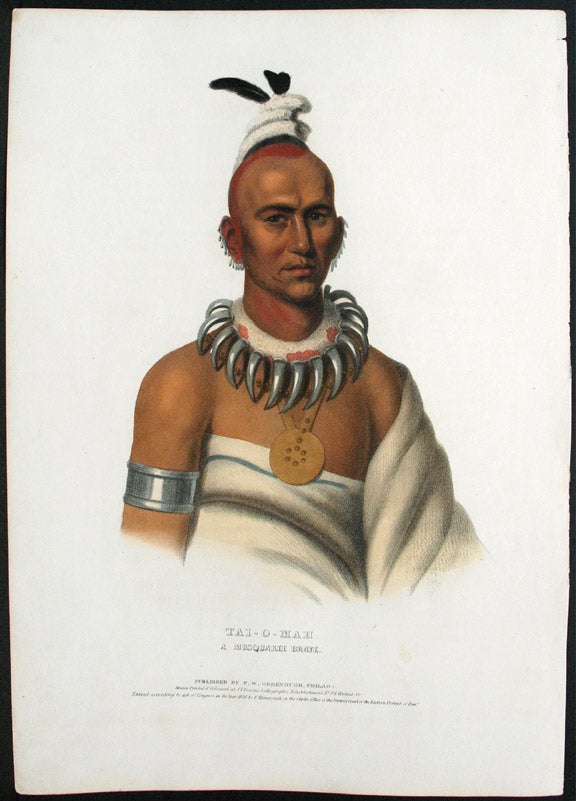MCKENNEY, Thomas L. (1785-1859) and James HALL (1793-1868)
Tai-O-Mah, A Musquakee Brave
Philadelphia: F.W. Greenough, 1838. Hand-coloured lithograph by J. T. Bowen. In excellent condition. Image size (including text): 13 1/4 x 8 3/4 inches. Sheet size: 18 x 12 3/4 inches.
A fine image from McKenney and Hall's 'Indian Tribes of North America': `One of the most important [works] ever published on the American Indians' (Field),` a landmark in American culture' (Horan) and an invaluable contemporary record of a vanished way of life.
Also occasionally referred to as the "medicine man", Tai-O-Mah or Taimah, "Thunder" or "He Who Shakes the Rocks" (c. 1790 - 1830) was an esteemed Fox warrior and chief who maintained an amicable relationship with the United States throughout his life. In 1824, he traveled to Washington as a member of the Sac and Fox delegation, led by General William Clark, which signed a treaty ceding their lands in northern Missouri and the southeastern part of Iowa to the federal government. It was during this visit to the capital that Charles Bird King painted the chief's picture after which McKenney's print was made. Taimah was also a leader of the influential Midewiwin or Great Medicine Society, a secret shamanistic society with religious affiliations that McKenney likened to the Freemasons. It is interesting to note given the calm composure which pervades his features that Taimah was suffering from tuberculosis at the time the portrait was being done. He is buried in Des Moines County, Iowa. McKenney and Hall's 'Indian Tribes of North America' has long been renowned for its faithful portraits of Native Americans. The portraits are largely based on paintings by the artist Charles Bird King, who was employed by the War Department to paint the Indian delegates visiting Washington D.C., forming the basis of the War Department's Indian Gallery. Most of King's original paintings were subsequently destroyed in a fire at the Smithsonian, and their appearance in McKenney and Hall's magnificent work is thus our only record of the likenesses of many of the most prominent Indian leaders of the nineteenth century. Numbered among King's sitters were Sequoyah, Red Jacket, Major Ridge, Keokuk and Black Hawk. After six years as Superintendent of Indian Trade, Thomas McKenney had become concerned for the survival of the Western tribes. He had observed unscrupulous individuals taking advantage of the Native Americans for profit, and his vocal warnings about their future prompted his appointment by President Monroe to the Office of Indian Affairs. As first director, McKenney was to improve the administration of Indian programs in various government offices. His first trip was during the summer of 1826 to the Lake Superior area for a treaty with the Chippewa, opening mineral rights on their land. In 1827, he journeyed west again for a treaty with the Chippewa, Menominee , and Winebago in the present state of Michigan. His journeys provided an unparalleled opportunity to become acquainted with Native American tribes. When President Jackson dismissed him from his government post in 1830, McKenney was able to turn more of his attention to his publishing project. Within a few years, he was joined by James Hall, a lawyer who had written extensively about the west. McKenney and Hall saw their work as a way of preserving an accurate visual record of a rapidly disappearing culture. (Gilreath).
Cf. BAL 6934; cf. Bennett p.79; cf. Field 992; cf. Howes M129; cf. Lipperhiede Mc4; cf. Reese, American Color Plate Books p. 24; Sabin 43410a; Horan 182.
Item #20600
Price: $850.00


